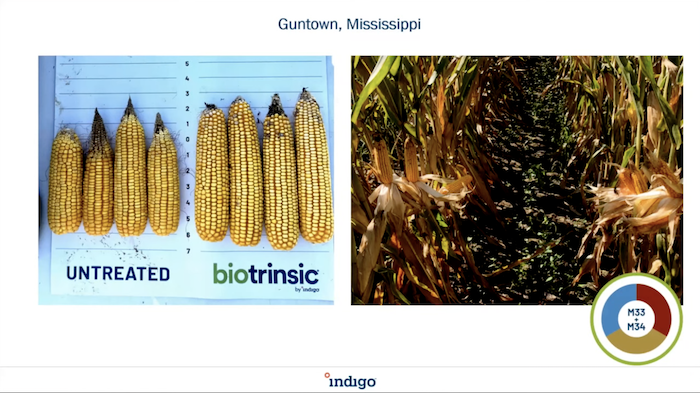Biologicals can produce favorable effects on corn plant development throughout the entire growing season to enable better yields in stressful environments, according to Indigo Ag experts.
Jim Cink, Indigo’s director of biological product marketing; PR Morris, technical service manager for Indigo; and Al Green, Indigo’s Senior Product Development and Enablement Manager; hosted a digital demonstration to teach no-tillers about three of the company’s products: biotrinsic W12, biotrinsic M33+M34 and the new biofungicide biotrinsic X19.
All three are flowable powder products that can be applied in the field during planting. Cink says the products are stable and have a 60-day window once applied to the seed.
“The microbes will be viable and give you that flexibility to plant when you need to,” Cink says.
Indigo tested the products with other major seed treatments for corn and soybeans, and the company did not find any compatibility issues.
“Microbes work with the plant continuously,” Cink says. “You can work to improve crop performance all season long. It helps plants start strong, continue to support for that plant — especially during stress environments — by moving nutrients into the plant when they’re needed, and then finish strong.”
biotrinsic X19 Biofungicide
Indigo biotrinsic X19 is a new biofungicide with multiple modes of action to induce systemic resistance, which boosts the plant’s ability to fight disease.
“X19 wakes up the plant’s immune system,” Cink says. “It induces a change within the plant to fight off and ward against diseases, and the microbes themselves also act as a defense-fighting mechanism with root colonization.”
Indigo had farmers everywhere from the Corn Belt to drought-ridden Kansas to humid Tennessee test X19 in corn on top of their usual seed treatments. Green says the addition resulted in a 5-bushel average yield uplift on 86% of acres.
“This is a product designed to protect seedlings as they’re coming out of the ground in early harsh environments,” Green says. “Getting that early start ended up being a winning position and benefited those growers.”

Photo: Indigo Ag
An Iowa trial completed with a split planter compared X19 to untreated acres across a variable field. Morris says the acres treated with X19 yielded 18 bushels more on average than the untreated acres.
“X19 performed well in the entire field,” Morris says. “It's not like we put the treated on the good area of the field and untreated on the bad. It was a split planter, so they went across the entire field.”
biotrinsic W12 for Drought Tolerance
Drought tolerance is critical during flower and grain-filling stages, according to Cink.
“For soybeans, one day without water is detrimental,” Cink says. “You have a 10-40% yield reduction during flowering and 20-30% yield reduction during grain fill.”
Cink says biotrinsic W12 helps microbes with group development and growth, which increases the surface area for intercepting moisture in the soil, and helps increase moisture transference within the plant. In 2022, Indigo gathered yield data from 42 no-till fields with W12 applied to the crop. Green says those farmers averaged a 6.5-bushel yield increase on 90% of acres with W12.

Photo: Indigo Ag
A trial from Fayetteville, Tenn., showed that X19 and W12 produced a bigger corn stalk diameter than an untreated check. While the corn ear length was the same among the X19, W12 and untreated plots, the treated ears had more rounds than the untreated. Morris says the W12 provided a 14-bushel increase over the untreated acres, and the X19 led to a 5-bushel increase over untreated.
biotrinsic M33+M34
Indigo’s M33+M34 is a combination of two lab microbes that protect the plant with nutrient uptake transformation and during drought stress. Cink says they work in the root zone to move nutrients and moisture into the plant.
“We’ve seen yield uplift by about 4 bushels per gram of M34 in R&D trials,” Cink says. “That’s the absorption of 17 pounds of nitrogen per acre that would have otherwise gotten underutilized.”
Cink says the microbes also help transform urea into ammonia, the useable plant form that can then get moved into the plant.
Thirteen trials in 6 states — including Kansas, New York, Nebraska and the Corn Belt — tested M33+M34 in 2022. Green says the product resulted in an 8-bushel per acre increase on average and provided a response on 92% of acres.

Photo: Indigo Ag
A Guntown, Miss., trial on heavier clay soils showed a dramatic difference in corn ear size with M33+M34.
“The 8 rows to the left were treated, and the 8 to the right were untreated,” Morris says. “Those two rows are 30 inches apart. There was nothing else different except for the M33+M34.”
Related Content
Microbials: The X-Factor for Your Corn [Digital Demonstration]
Indigo Ag Releases Novel Biofungicide
[Webinar] Why Farmers and Buyers Are Coming Together in the Indigo Carbon Program







